

ART

HANNAH ANDRES
Artist Statement
I didn’t know what I was making when I started drawing—no rough draft, sketch, or even story concept. I wanted to discover the world as I was creating it and for others to discover stories for themselves as well. If you haven’t taken a good look yet, I would encourage you to before reading further because what I discovered about the story may not be what you do in looking at it yourself (and my own opinion will surely change as I keep drawing).
This year, much has changed. Ironically, previously my work has dealt with the fear of the unknown, the darkness and beauty wrapped up in change. And while this piece deals with similar themes, sleep has been a concept that was revealed to me through my subject matter. In the center of the drawing that I have so far is the figure of a woman with her arm out stretched, blinded and commanding. To me, she is sleep. Sleep is peace, a moment to breathe, grow, and heal. But it also brings connotations of passivity and unawareness. As I continue drawing, I will be adding more human-like spirits who are interacting with her, such as the figure in the back who has fallen asleep and become still like a mountain. A woman in the foreground, who is drawn in pencil but not inked yet, will symbolize growth, and further characters will symbolize destruction, action, and hope. I’m not attempting to make everything a one to one comparison, however. Sleep also connotes dreams—vague, bizarre, and from which many different meanings can be taken from. In the same way, the drawing is a dream world of its own, ready to be adventured in.
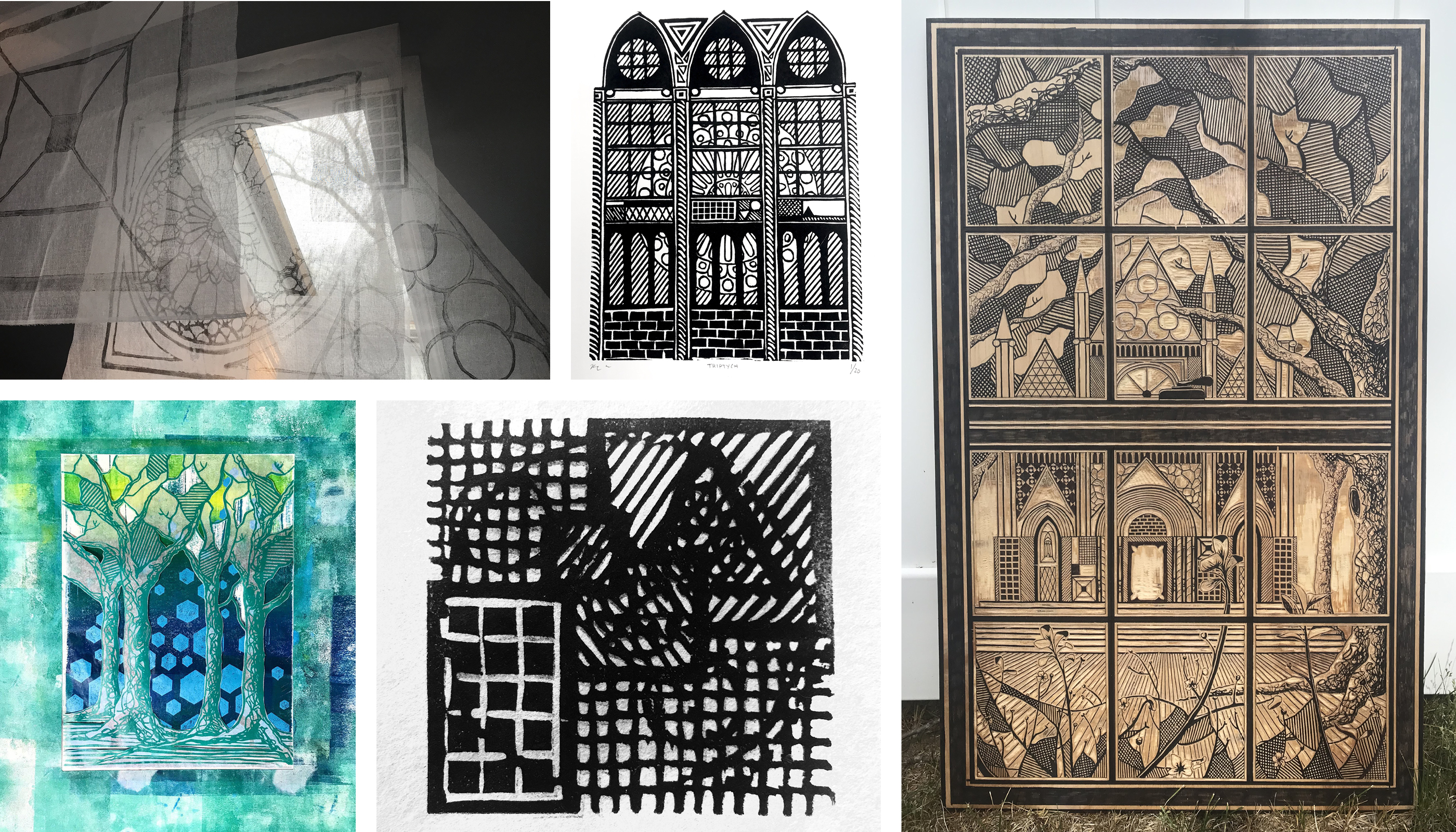
KATHRYN BERCHIN
Artist Statement
As I’ve considered how our relationship to place impacts our way of being, I have been searching for a way to share with others the experience of taking on multiple places and having those places become a part of the fabric of who we are. While transitioning home after studying abroad last year, I started to take on and live out what I had learned about the deep connections we are capable of having with people and places. I started to realize that I could develop that same level of connection with the present and that developing those connections with many places—not only the ones I was longing for—would enable me to embody all that I had come to dearly love and to love all that I had not yet embodied. This time of discovering who I had changed into after such a significant experience led to my idea for an installation which combines the elements of many places into one, dynamic, cohesive space, causing those who engage with it to experience what it is like to embody multiple places.
However, my process in the last few months has been transformed by being in isolation. Instead of solely working on the installation idea which flowed from my experiences pre-quarantine, I am now making prints that speak to the tension of being locked down while having been changed by many places. Soon, we will all be together again having been changed by a shared experience of encountering the unfamiliar—this strange place that stunts and grows, brings grief and beauty, and is utterly exhausting to encounter. Perhaps we will eventually find that it is one of the many places that speaks into the fabric of who we are. My hope is that my work pre- and post-quarantine will be in dialogue together—that this current place will speak to the places I’ve embodied and that those places will help me embody this place.

MEREDITH FREE
Artist Statement
For centuries across cultures and continents, tree imagery has helped individuals process, integrate, and reconcile with death. Imagery of trees provides those bereaved with an external place in which to process, accept, and recontextualize their experience of death into the rest of their lived experience, resulting in a realization of greater wholeness. Trees are not merely used to depict grief, rather trees appear to merge with the bereaved to embody the complex nature of grief.
I have sought to capture something of this incomprehensible significance by using tree imagery to interpret memory. Trees provide a place for the unplaceable memories of trauma and grief and become a reliable guide who lead the bereaved back through the ambiguities of memory. By reflecting on the death of my mother four years ago, I sought a visual language to capture the incomprehensible significance of memories in grief.
The process I developed in these paintings involves many layers of acrylic paint that are scraped and sanded away, leaving remnants of color clinging to the surface, and uncovering stratified layers beneath. Often a violent process, this technique embodied and transferred to the surface of my paintings the abrading feeling of grief. In some cases, I applied nihonga as the final layer—a traditional Japanese painting technique that utilizes finely crushed minerals as pigments. Through active creation and destruction, an elusive beauty emerged in the paintings which spoke to me of the soul-ripping sublimity grief.
These paintings condensed my sense of my mother’s presence, and more importantly, made tangible the presence of her absence. The lack of her presence filled these images of trees, giving me a place in which to bestow the thoughts, memories, and love which no longer have a physical manifestation. The process and result of my paintings have allowed me to find a way back to the tree of life, to the wholeness that existed in my world before my mother departed it.
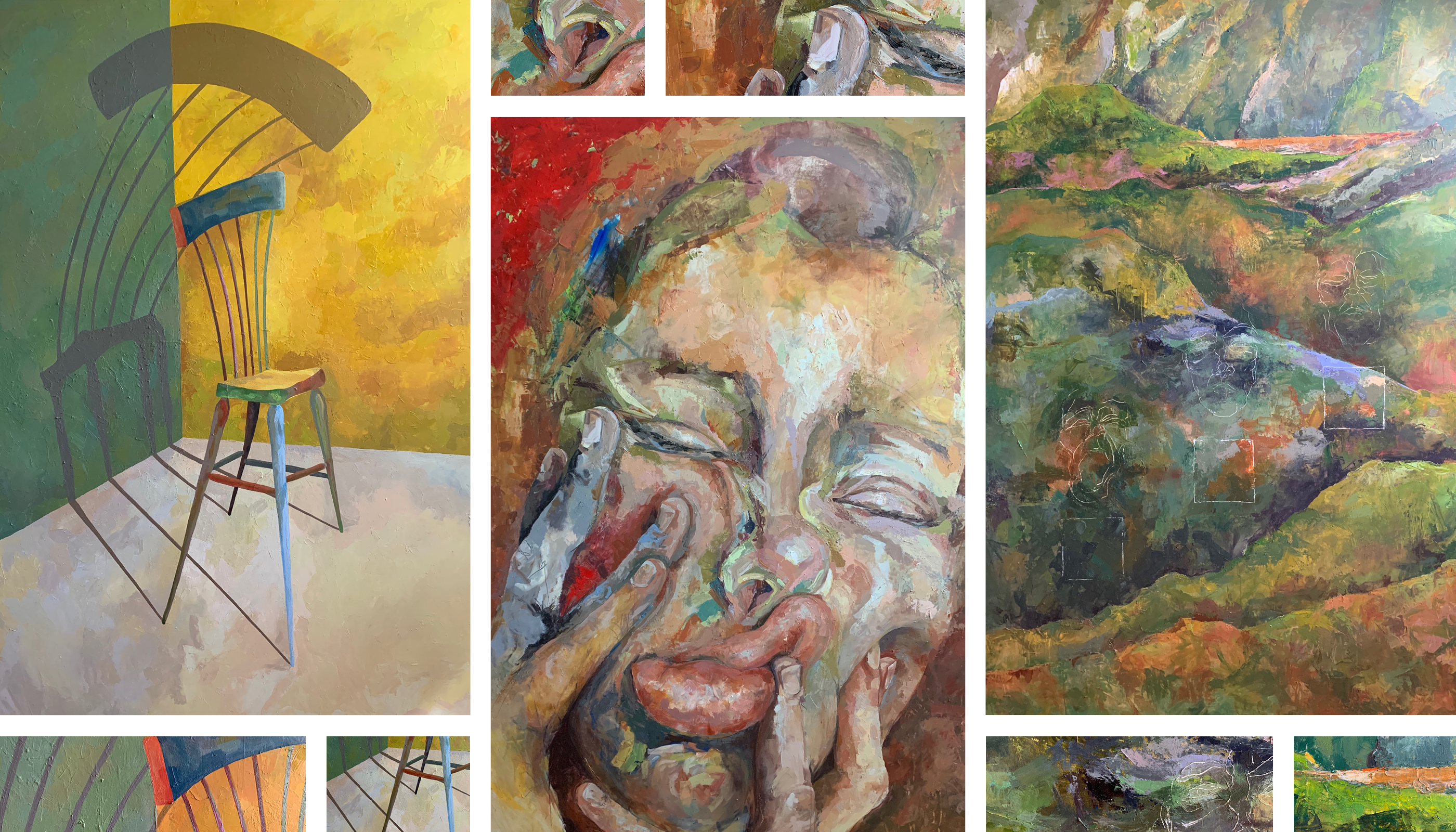
MICHAELA LICK
Artist Statement
This development of work stems from my curiosity concerning what the mind subconsciously visualizes without permission from the individual. Within one’s own dream state subconscious visualization has the space to flourish and explore without permission. My original encounter with what this body of work would become, came about in the form of a dream. After attempting to fluently replicate what I had envisioned I came to realize it would be necessary to hold loosely to my initial beginnings.
The process of making this body of work became reflective of more than just the imagery within my dreams, but began to encapsulate more perplexing notions. The allure of painting stems from its ability to explore beyond the ideational inception of an idea, allowing one the ability to enter and inhabit other spaces. In order to fully explore this idea, I found it important to heavily rely on the material for substance rather than the subject matter; to explore where the vision led to, I left space for change and manipulation.
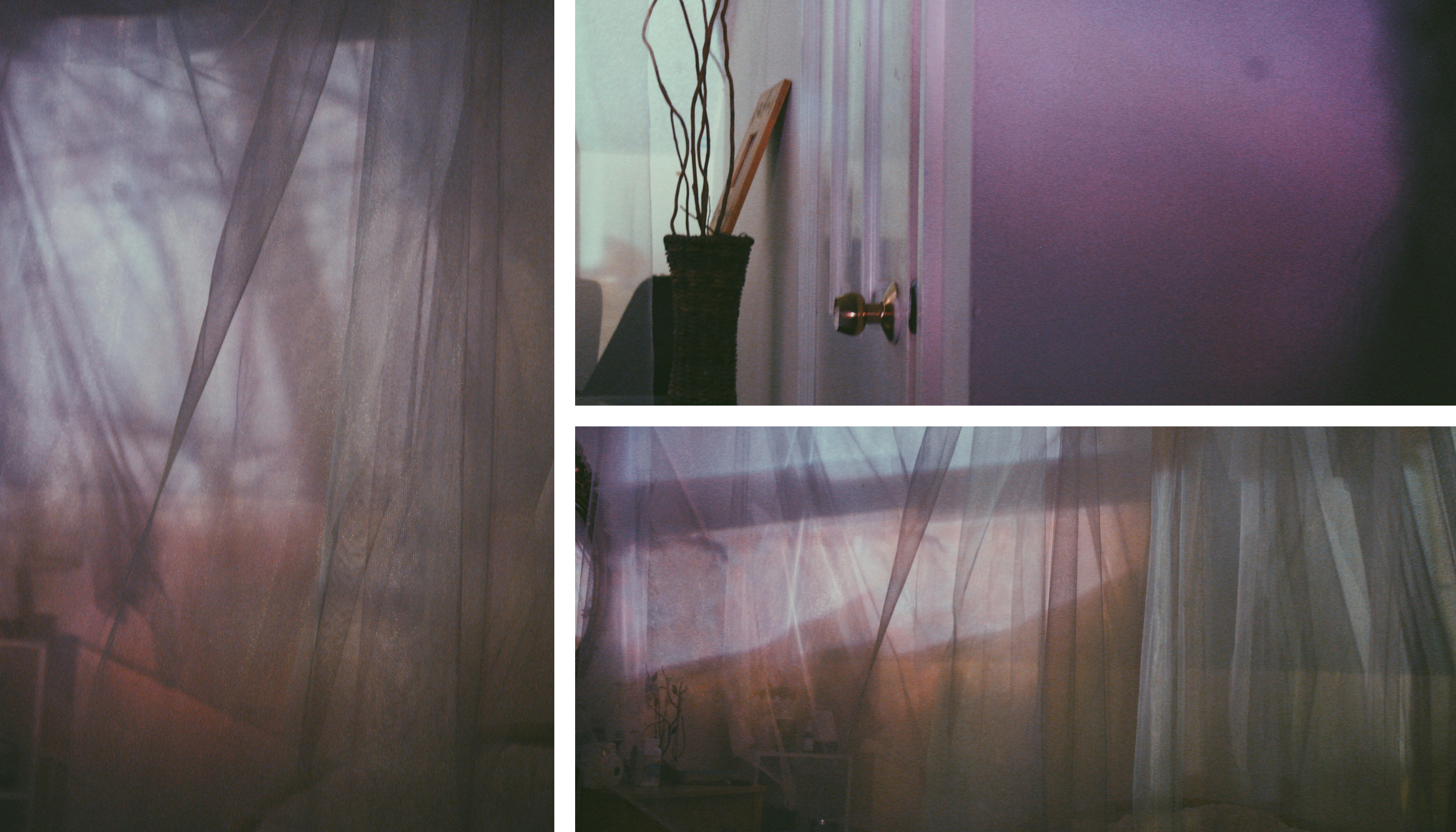
MARYKATE MCKINNEY
Artist Statement
This is how I remember:
I reflect; feeling when
moments
were like a warm glow or when
they were a biting cold,
flashing
back and forth between the
past and the present. At the
end of remembering,
everything slows down and I
am back in my reality.

JOSH PETERMAN
Artist Statement
This series of collages was created throughout the beginning and rise of the COVID-19 pandemic. The plethora of "things" that happened in the months since February were filled with incredible strife, both globally and personally to the artist. These emotions ranged from extreme joy in new beginnings to grief and sorrow in death. These collages were created to work through a vast spectrum of personal emotion regarding these circumstances. Each piece of imagery and material was chosen based on the immediate feelings of the day they were created in an attempt to capture the emotions rushing through each moment. Often when things began to feel steady a new disruption would shift the routine desperately craved. Yet when all seemed to fall apart, there would always be a small hope for the next day; a hope that someday, everything would be okay.
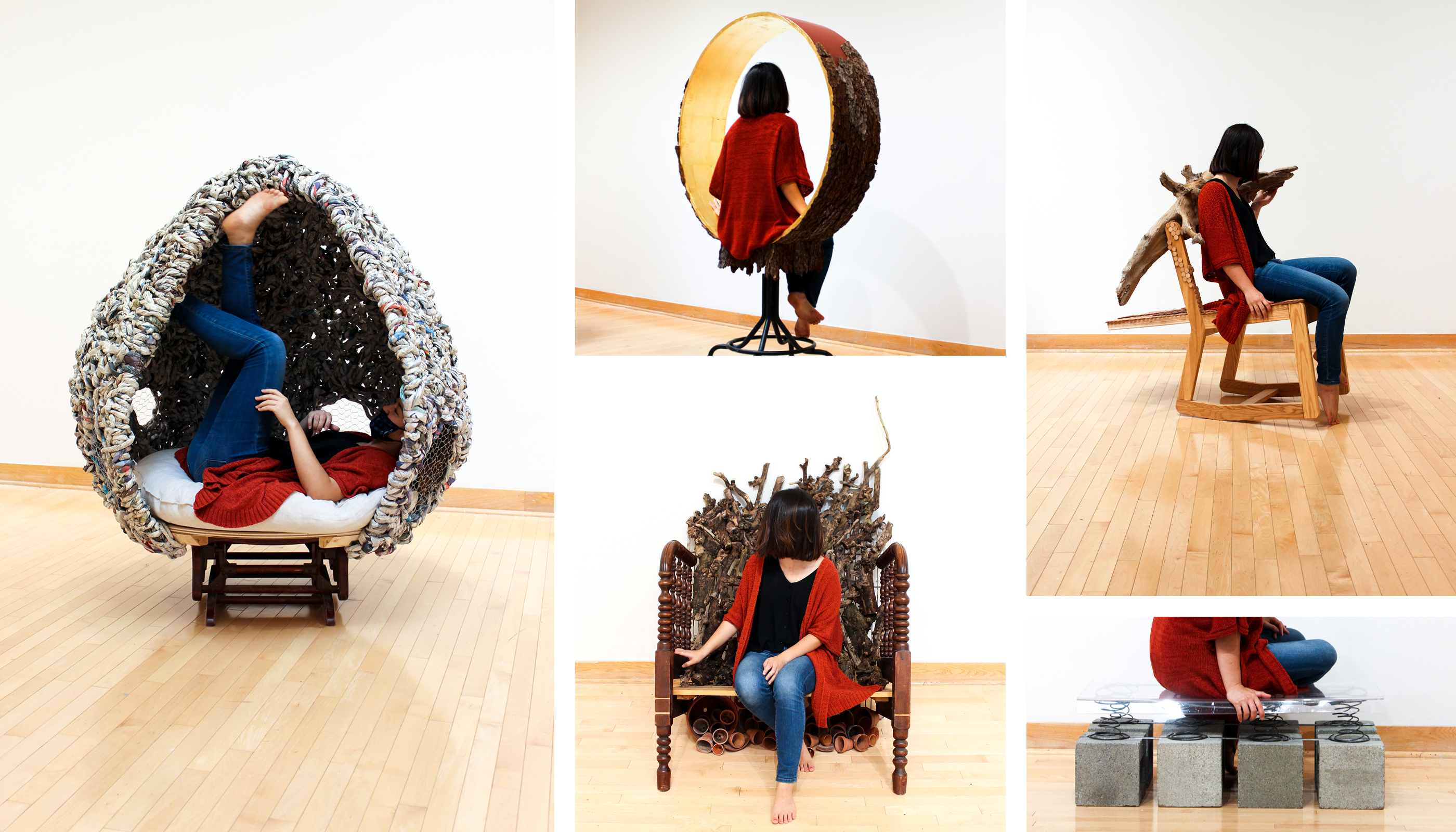
EMMY SHORT
Artist Statement
Chairs trace the human body with arms, legs, and a torso. They have different personalities that draw us to them and impact how we exist in space. Some chairs offer support and facilitate focus, while others encourage playfulness and foster community. Over time, they develop intimate relationships with our bodies and yet are often taken for granted for the particular ways they impact our experience of everyday life.
This series uses the concept of a chair to explore my relationships with six college friends. Each chair is a sculptural portrait that repurposes pieces of broken chairs and other found objects to create seating environments reflecting my relationships with them. Viewers are invited to engage not only visually, but also physically and perhaps encounter glimpses into the unique personalities of my chair-friends.
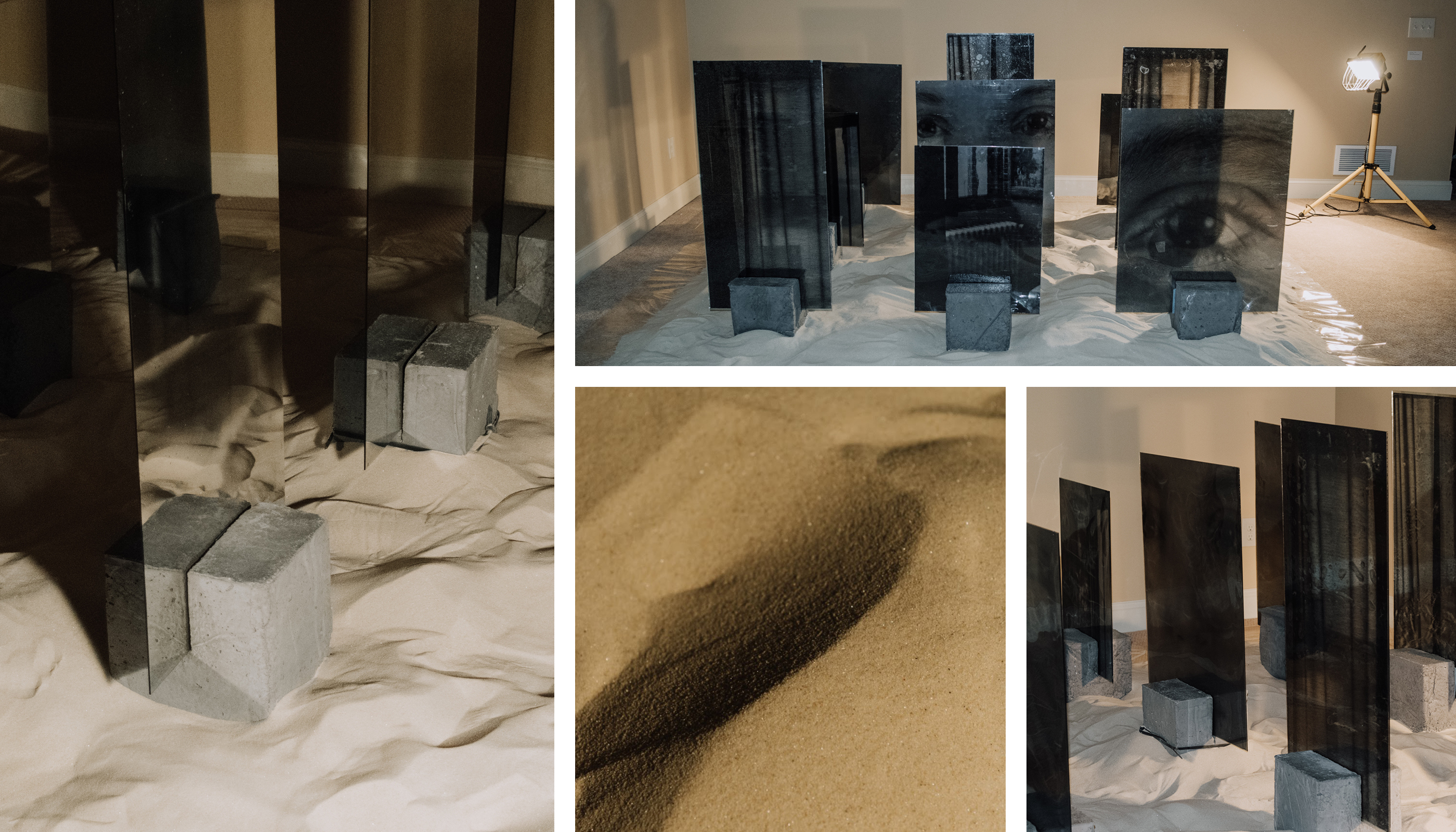
KAITLYN WULF
Artist Statement
Medium: photo on acetate, glass, concrete, sand
The current manifestation of this piece is an exploration of the fragmented nature of memory, the self, and view of the other. It is both a meditation on and a confrontation between simultaneous connection and separation. In images and reflections, it holds memory and the self up as monuments, but in a disorienting isolation.
Other Department Projects:
Biblical Studies and Christian Ministries
Communication Arts
Computer Science
Creative Writing
English
Music
Psychology
Theatre Arts

